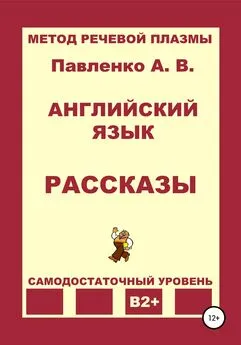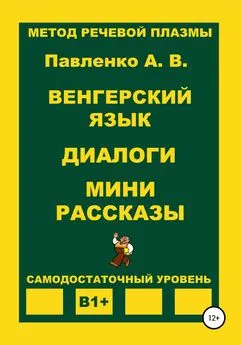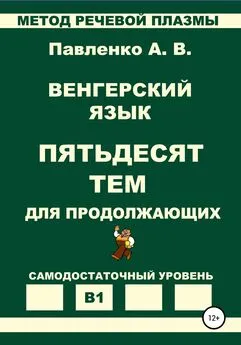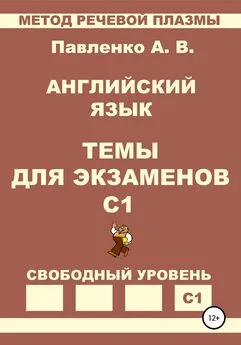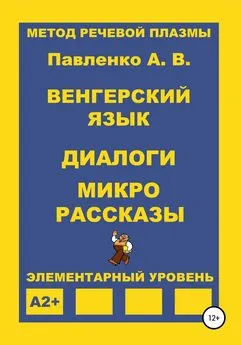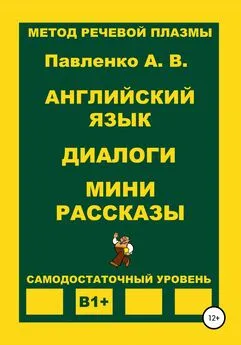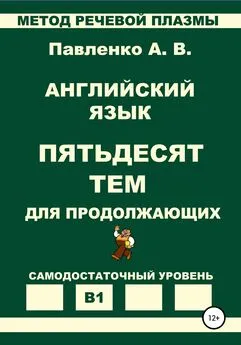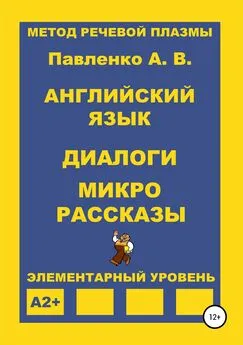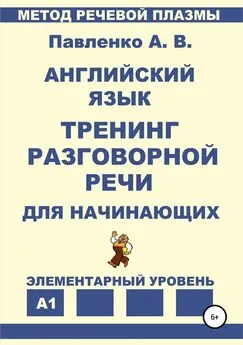Александр Павленко - Английский язык. Рассказы. Уровень В2+
- Название:Английский язык. Рассказы. Уровень В2+
- Автор:
- Жанр:
- Издательство:неизвестно
- Год:2022
- ISBN:нет данных
- Рейтинг:
- Избранное:Добавить в избранное
-
Отзывы:
-
Ваша оценка:
Александр Павленко - Английский язык. Рассказы. Уровень В2+ краткое содержание
Английский язык. Рассказы. Уровень В2+ - читать онлайн бесплатно ознакомительный отрывок
Интервал:
Закладка:
Александр Павленко
Английский язык. Рассказы. Уровень В2+
A Trip to Crete
Last year my wife and I spent our holidays in Crete, the southernmost island in Greece, and we made lots of little excursions there into the countryside. On one occasion, we wanted to visit the south side of the island, where there are some ruins from the Roman times and from a former monastery. We went there by bus, travelling along tiny little windy roads. It was quite frightening to watch how the bus driver was manoeuvring the vehicle around all of the twisty curves in the road, quite breathtaking. At every curve we were scared that the bus would crash, and the bus driver had to signal with his horn at each turning as it was impossible to see if any traffic was coming from the other direction and there wasn’t enough space on the road for two vehicles to pass side by side.
When we arrived at the nearest bus stop to the ruins, we could see them in the distance, and we could see that there were only two ways to get there – on foot, or by boat, if we had one, which we didn’t. So, we started walking in that direction, along a dried up river bed. From the map it seemed that the distance we had to walk was about three kilometres, but it must have been longer, as it took us about three hours of difficult climbing and scrambling over rocks to get there.
At one point on the way we reached the top of a hill, from which we had an amazing view of the ruins. There we met a boy from France, who we shared friendly gestures with, but couldn’t really speak with as we didn’t speak a foreign language. We climbed down from there together, into the grounds of the ruins. There was a fence blocking our path, but it was quite small and easy to climb over.
In the grounds of the ruins were some very twisty, gnarled old olive trees, and at the entrance we found a beautiful mosaic from the Roman times, leading to many little paths. The monastery was very small. Each of the monks’ cells were just tiny little box-like rooms, two by three metres in size. The whole place had a beautiful, ancient atmosphere.
By the time we got there we were very tired after so much walking and weren’t looking forward to the long trek back to the bus stop. We weren’t even sure that we would get there in time for the last bus. Fortunately, we met a fisherman on the beach, who was there fishing for octopuses. He was kind enough to take us back to the road by boat, which only took about ten or fifteen minutes, and the walk to the bus stop from where he dropped us off was very short. We were well in time to catch the bus. We were very happy, if a little exhausted, after a nice, interesting trip.
A Trip to Crete
1. Where did they spend their holidays last year?
2. What did they do while on holiday?
3. Why did they want to visit the south part of the island?
4. How did they get there?
5. Why did they find their trip frightening?
6. What were they afraid of?
7. Why did the driver have to signal with his horn at turnings?
8. How could they get to the ruins from the bus stop?
9. How long did it take them to get there?
10. Where did they meet a boy from France?
11. What was the trouble communicating with him?
12. What did they have to get over when they got to the ruins?
13. What did they find at the entrance of the ruins?
14. What size were the monks’ cells?
15. What did they think of the place?
16. Why weren’t they eager to walk back to the bus stop?
17. What could happen if they had walked to the bus stop?
18. Who did they meet?
19. What was the fisherman doing there?
20. What was the favour he did them?
21. How long did the boat trip take?
22. Did the fisherman drop them off at the bus stop?
23. How did they reach the bus stop then?
24. Did they catch the last bus?
25. How did they feel at the end of the day?
A Trip to Crete
Training 1
They went there by bus, travelling along tiny little windy roads. It was quite frightening to watch how the bus driver was manoeuvring the vehicle around all of the twisty curves in the road, quite breathtaking. At every curve they were scared that the bus would crash, and the bus driver had to signal with his horn at each turning as it was impossible to see if any traffic was coming from the other direction.
Training 2
There were only two ways to get to the ruins – on foot, or by boat. So, they started walking in that direction, along a dried-up riverbed. From the map it seemed that the distance they had to walk was about three kilometres, but it must have been longer, as it took them about three hours of difficult climbing and scrambling over rocks to get there.
Training 3
At one point on the way they reached the top of a hill, from which they had an amazing view of the ruins. There they met a boy from France, who they shared friendly gestures with, but couldn’t really speak with as they didn’t speak a foreign language. They climbed down from there together, into the grounds of the ruins. There was a fence blocking their path, but it was quite small and easy to climb over.
Training 4
In the grounds of the ruins were some very twisty, gnarled old olive trees, and at the entrance they found a beautiful mosaic from the Roman times, leading to many little paths. The monastery was very small. Each of the monks’ cells were just tiny little box-like rooms, two by three metres in size. The whole place had a beautiful, ancient atmosphere.
Training 5
Fortunately, they met a fisherman on the beach, who was there fishing for octopuses. He was kind enough to take them back to the road by boat, which only took about ten or fifteen minutes, and the walk to the bus stop from where he dropped them off was very short. They were well in time to catch the bus. They were very happy, if a little exhausted, after a nice, interesting trip.
Pub Music in Edinburgh
I first became involved in playing Irish music many years ago when I first visited Ireland and was greatly inspired after attending some great folk festivals there. The first one I went to was in County Sligo, in Ballisadare. There were so many great groups playing there – DeDanaan, The Bothy Band, Clannad, all the best-known Irish musicians of that time. There were thousands of tents and thousands of people everywhere, and there was a really great atmosphere. The whole thing lasted for three days, and I had a really nice time.
What struck me most was the power of the sound of the fiddle, such a fantastic instrument. I took up the fiddle when I was a small child but dropped it when I came to the age of about thirteen. But after seeing those folk play in Ireland, well, I had to pick it up again. I brought some sheet music back from Ireland, and when I got back home to Dorchester, joined a local folk music club and tried a few tunes. First, we played the tunes very slowly. You wouldn’t recognize them because they were so slow, but gradually I learnt a few of them by heart.
Then I moved to Edinburgh, because my wife, Sophie, is a scientist, and she got a grant to go and work at the University of Edinburgh. She was looking for a place to work where she could work well and expand her knowledge, and at the same time somewhere where I would feel happy. We considered Ireland and Scotland, and eventually decided upon Scotland. I found some work there too. I am also a scientist, a biologist, specializing in mosses. There are so many mosses in Scotland, and I knew people up there who were also involved in studying mosses, so I found myself working for the peat land section of the Scottish Heritage Trust. At home I’d just finished a big study on heavy metal deposition, which can be gauged by analyzing mosses, and I had some good opportunities to talk with other experts about my results, as well as to collect mosses.
My time in Edinburgh was one of the finest times of my life, because I enjoyed my work, and there was great music in the evenings. I went out three times a week to folk music sessions, which took place in a few of the local pubs, and met some really great musicians there, some lovely people. We’d go in and sit down in the pub at the beginning of the evening, have a drink, and would be chatting away when someone would get out their instrument and start playing. Then others that knew the tune they were playing would join in. Some people would play regularly in each pub, and there were always people passing through. The first session I went to I discovered by luck. I just went into the pub and saw that there were people playing, and once you’re in one session it’s easy to find out from the musicians the times and places of others. I really was a bad fiddle player at the time, but I tried to play a bit and listened a lot, and people were very kind to me and took me to lots of sessions. I’m not a great player at the moment, but I think I’ve improved a bit since then! I took a portable tape recorder with me and recorded, session by session, many tunes, and tried to learn some of them when I had some spare time. I learned a lot from listening and watching how others played – and there were some really talented players in Edinburgh at that time, like John Martin, for example. You can’t imagine how good some of the playing was. There were also people playing the mandolin and the flute, Irish pipes and guitars.
A lot of people from Northern Ireland, particularly from Donegal, used to come to the Edinburgh sessions, and they were a strong influence. There are some pubs where people play Irish music there, and some where people play Scottish music. There were always more people playing in the Irish sessions, maybe because Scottish music is usually played by a solo instrument, maybe with a guitar accompaniment, whereas in Irish music you often find five or six fiddles playing together, which is, I think, more exciting. Also, in the Scottish sessions, you’d very rarely hear any songs, which were more common in the Irish ones.
I wouldn’t have liked to live in Edinburgh forever, but I had a really fantastic time there and I was sad to leave. The time there was too short, even for our kids. The kids went to school there, and for our son it was the first time he’d been to school. They both picked up a strong Scottish accent!
Pub Music in Edinburgh
1. When did Greg first become involved in playing Irish music?
2. What was the first festival he visited like?
3. What struck him most at the festival?
4. When did he take up fiddle?
5. Why did he have to learn playing it again?
6. How did he pick up the fiddle back home?
7. Why did they move to Edinburgh?
8. What did Greg and his wife do?
9. What about Greg’s work in Scotland?
10. Why did he enjoy living in Edinburgh?
11. How often did he go to folk music sessions?
12. Where did they take place?
13. What did they do at the sessions?
14. How did he happen to discover those sessions?
15. How did he turn into a regular session player?
16. What kind of fiddle player was Greg at the time?
17. Has he improved since then?
18. What did he do to improve?
19. What other instruments did some of the musicians play?
20. Did they only play Scottish music in the pubs in Edinburgh?
21. How did it happen that there were Irish sessions in Edinburgh?
22. Why were there more people playing in the Irish sessions?
23. Were songs typical for Scottish sessions?
24. How did he feel when he had to leave Edinburgh?
25. Why was that time prominent for their children, too?
Читать дальшеИнтервал:
Закладка:
